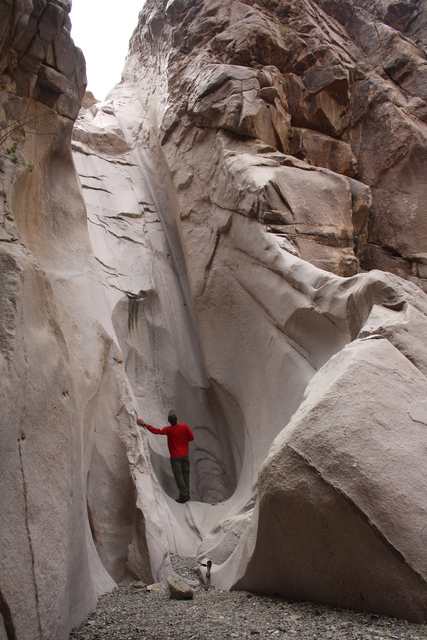Day Trips: Keyhole Canyon a great place for ancient rock art viewing
If you are looking for an easy outdoor excursion for the entire family, just head just south of Boulder City to Keyhole Canyon.
A narrow canyon in the mountainside, filled with petroglyphs and a few pictographs, and culminating in a smooth dryfall, the place has a unique, romantic, and almost magical feel. It’s a great place to spend a spring morning, and exploring the canyon itself is such an easy, short hike that just about anyone in your family can enjoy it.
The canyon is located at an elevation of 2,854 feet in the western foot of the Eldorado Mountains, and managed by the Bureau of Reclamation. A four-wheel-drive vehicle and good off-road tires will easily get you to the trailhead at the canyon mouth. In mild weather, an experienced hiker can even get there on foot from the hard-surfaced road.
Keyhole Canyon itself can be hiked in only 15 minutes or so, but any additional time you spend viewing and photographing the rock art will be well invested, paying off in memorable photos and vivid memories.
The rock here is mainly quartz monzonite. As you approach the canyon you will notice a dark coating on the cliff faces and boulders which is called desert varnish. It forms over rock throughout the arid Southwest. Much of the varnish is black but some have a more red patina. It is composed of clay particles with the addition of iron and manganese oxides, as well as trace elements.
Rocks covered with varnish are the most common locations in our region to find pre-historic American Indian petroglyphs. This kind of art was made by pecking away the varnish with some hard object, exposing the lighter color underneath.
Most of the glyphs here are abstract, ranging from simple lines to complicated symbols, although you will find recognizable figures such as human forms, bighorn sheep and lizards. The best place to see them is at the mouth of the canyon just yards from the parking area. Bring binoculars to get a good look at those panels that are located high up on the cliff walls.
Once within the mouth of the canyon, look around among the large boulders on the south side, and you will also find a few pictographs. These were painted on the rock, and those that remain today are found in protected areas such as overhangs and other areas protected from the weather by the boulders. In this canyon, they were painted with red ochre, a natural clay pigment.
Rare sights you will find here are cupules. They suggest small, a few inches or so, circular scooped-out cups for ice cream. I have seen them on tops of boulders near the parking area on the left side of the canyon. It is said they were used for ceremonial purposes by American Indians.
Do not climb on or within 100 feet of any rock art. Also, it is important to remind every one of your group not to touch the rock art as the oil from our hands will damage them. This time of year, rattlesnakes are still out and about, so remember to never put your hands or feet anywhere you haven’t looked first.
Directions to Trailhead:
- From Pahrump take NV-160 south about 52 miles to Las Vegas. Merge onto I-215 east and drive about 12 miles.
- Merge onto I-215 east and drive about 12 miles.
- Merge onto I-215 east and drive about 12 miles.
- Merge onto US-93/95 south and drive about 8 miles.
- Exit right on U.S. 95 south toward Searchlight. Drive for 15.7 miles and go left through the median on the paved crossover. (This will be 5.9 miles after the Nelson turnoff.)
- Follow this gravel road for 2.1 miles and go right at the power lines.
- Follow the powerline road for about 1.8 miles, then go left just after power-line tower 23E3.
- Follow this track for about 0.3 miles to parking area.
Deborah Wall is the author of “Base Camp Las Vegas, Hiking the Southwestern States,” “Great Hikes, A Cerca Country Guide,” and co-author of “Access For All, Touring the Southwest with Limited Mobility.” Wall can be reached at Deborabus@aol.com.


















